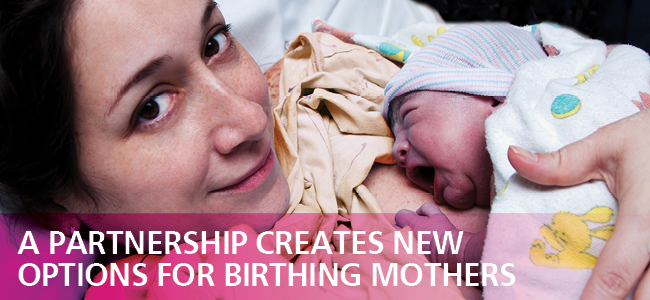Strategic Plan Area of Focus: Health for Women

When the Toronto Birthing Centre opens later in 2013, women in the Toronto area will have another important option in their choices for giving birth. In addition to hospital birth or home birth attended by a midwife, women with low-risk pregnancies under the care of a midwife will be able to deliver at the new birthing centre. It will be a midwife-led facility where women who would prefer not to give birth at home can still choose to receive out-of-hospital, community-based care.
Women’s College Hospital (WCH) has partnered with Seventh Generation Midwives Toronto (SGMT) to create the Toronto Birthing Centre which will focus on improving access to care for frequently underserved groups, including Aboriginal women, immigrant women, inner city women, women who identify as LGBTQ, refugees, teens and the noninsured. The centre will be open to all women under the care of a registered midwife, and will be located in a free-standing facility, in a high-needs neighbourhood, in the downtown area.
“Our experience has been that when you make care accessible to the most vulnerable, you’re actually making it more accessible to everyone,” says Cheryllee Bourgeois, general registrant Aboriginal midwife with SGMT, a Toronto-based midwifery practice with a focus on Aboriginal women. “That’s the same philosophy that we’ve tried to carry over in setting up the birth centre – looking at our systems and trying to create many points of access to the birth centre, making it as open as possible to reaching those communities.”
A birthing centre provides an opportunity to move birthing care into an ambulatory setting. There will be different supports in the birthing centre than a woman may have access to in a home birth, and midwife-assisted out-of-hospital birth is expected to be a cost-effective alternative to hospital birth. This partnership renews WCH’s association with birthing within the context of ambulatory care, and fits WCH’s strategic plan goals of providing health system solutions, and identifying and filling care gaps in health for women.
Meeting unmet needs for women is really the focus,” says Heather McPherson, vice-president, patient care and ambulatory innovation at WCH. “We know that with many of the populations that we’re targeting with the birthing centre there’s a gap in services related to prenatal care and deliveries. Having an option that’s not hospital-based would be very good for them and very good for the health system.
The Toronto location is one of only two birthing centres opening in Ontario with the support of the Ministry of Health and Long-Term Care. The second centre will be located in Ottawa.
“What’s really exciting about this is that the Ministry of Health created a whole new designation for these birthing centres. They are going to be independent health facilities,” says McPherson. “They’ve created a whole new structure and standards for birthing centres.”
WCH will be providing institutional support and ancillary services for the Toronto Birthing Centre, handling elements such as human resources, security and infection control. SGMT patients also have access to prenatal classes offered at WCH, and as the partnership evolves, the hospital will also be a resource for referring midwifery patients for specialist care at WCH, such as mental health and diabetes management.
Another objective set for this centre is to be an education facility where learners from multiple health disciplines will be trained in low-risk birthing. This is another important goal that WCH fulfils as part of its role as an academic hospital.
WCH’s partnership with SGMT and the Toronto Birthing Centre takes the hospital’s institutional expertise in academic, ambulatory care beyond its walls and into the community. McPherson notes that the hospital’s strategy of supporting healthcare for women is not always about providing services onsite at WCH
“It’s about the bigger picture of gaps in care for women, and helping to facilitate that,” she says. “In this case, that means bringing administrative and infrastructure knowledge to the table and in so doing, improving patient care.”
